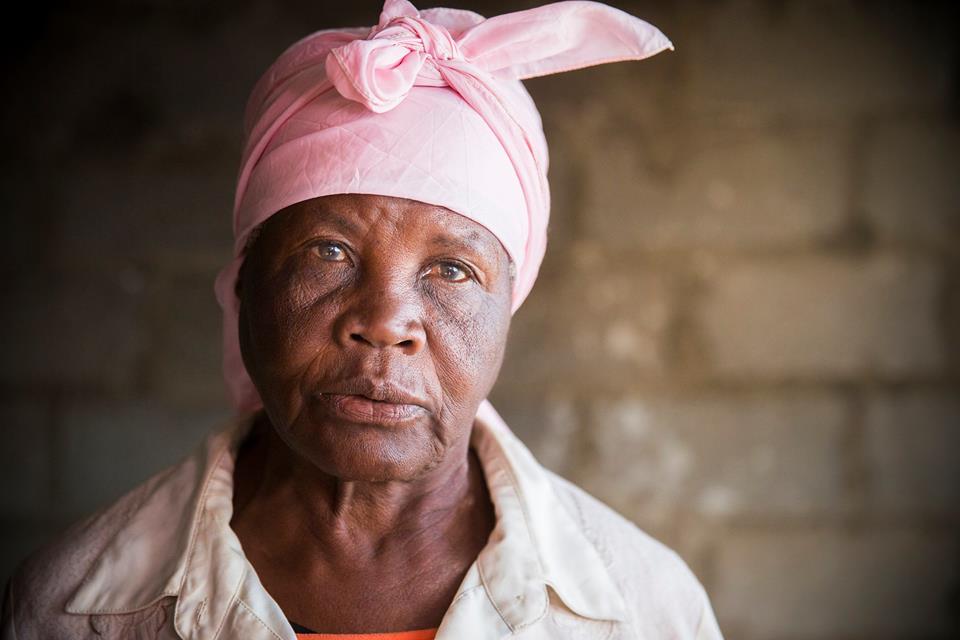Since 2007, Irish Aid has co-funded Habitat for Humanity’s Pamwesu project in the Lusaka and Ndola provinces in Zambia.

This project aims to promote equitable development and human rights amongst women, orphans and children made vulnerable by HIV/AIDS in Zambia. This August, thanks to Irish Aid, and your incredible support, a new 3-year phase of this project began.
Meet Enessi (right). She lives in a Habitat home in Zambia where she cares for her 6 orphaned grandchildren. Habitat’s Pamwesu project means that families like Enessi’s can stay together, feel protected and thrive.
Over the next three years, we will answer questions about this project on our blog.
The first question is:
As part of the Pamwesu project, Habitat for Humanity Zambia partners with Community Based Organisations (CBOs) and other Non-Governmental Organisations (NGOs) that already work in the seven targeted communities in the Lusaka and Ndola provinces. These organisations provide essential services such as nutrition, education and psychosocial support.
Through engagement interventions, such as meetings and focus group discussions, CBOs/NGOs have an intimate understanding of community and family needs at household level. As a result, these partners mobilise families and identify qualifying families for this project. The identified families are then vetted by the Habitat Zambia committee. The vetting committee comprises representation of staff from four departments, namely Programmes, Resource Development and Communications, Finance, and Administration – who bring on board their expertise to improve programme delivery.
Orphans and Vulnerable Children (OVC) Family Selection Procedure
The following Family Selection Procedure is used to select programme beneficiaries:
– Community Awareness: A date, time and venue for a community education and eligible family identification meeting is announced to CBOs.
– Education Meeting and Beneficiary Identification: The implementing partner then identifies and presents names of vulnerable households they think meet the Habitat Zambia OVC family selection criteria to the Habitat Zambia Social worker. Following that, a community education meeting takes place. Information on the basic requirements for qualification for housing support is provided and expectations of the family are communicated. During this meeting the seconded families complete an OVC Household Beneficiary Assessment and Identification Form. The HFHZ Social Worker then notifies the committee of the list of families for home level verifications.
– Field level Home Verification: During the vetting, information provided by the applicant on the application form is verified and the committee determines whether or not the applicant qualifies. Verification forms with names of those approved or rejected are then submitted to the Habitat Zambia National office (Head Office) in Lusaka. The Chairperson of the vetting committee then submits a final report of the families to be served to the Programmes Manager at Habitat Zambia.
– Construction: Once the selected beneficiary’s materials are on site, construction may begin.
– House Completion Certificate: When construction has been completed, the selected beneficiary will sign a house completion certificate, which gives ownership of the house to the beneficiary. A house dedication ceremony is held at a later date for all families that benefitted from a given round of funding.
The Zambian government defines an orphan as a child below the age of 18 years who has lost one or both parents. A vulnerable child is below the age of 18 years and has been in or is likely to be in a risky situation where he or she is likely to suffer significant physical, emotional or mental stress that may result in the child’s rights not being fulfilled.
Orphan – Child under the age of 18 who has lost either his/her father or mother or both to death.
An orphan may fall under the following categories:
– Paternal orphan – child under 18 who has lost his/her father
– Maternal orphan – child under 18 who has lost his/her mother
– Double orphan – child under 18 who has lost both parents
Vulnerable – child under the age of 18 who is living in the any of the following conditions:
– Child living with HIV/AIDS
– Child of parents living with HIV/AIDS
– Child living with parents with a physical disability
– Child head of household
– Child abandoned by his/her parents
– Child whose parents are caring for additional orphans or vulnerable children
– Child living with persons too old to take care of them
– Child living with parents that are struggling economically
Habitat Zambia takes into account the definition of orphans and vulnerable children given above in the identification and verification process of families eligible for the Vulnerable Group Housing Project.
Families to be prioritised for Vulnerable Group Housing will therefore need to meet the following conditions:
– Living in poor structure (i.e. semi-permanent or temporal structures (tents), leaking roof, without a roof, without floor, with broken/rotting/eroded walls). Families without houses but own land and have title may also benefit from the project.
– Poor sanitary facilities (No toilet/ pit latrine) – this is an important health-based indicator.
– Low-income households taking care of OVC; living below the poverty datum line.
– Families with members that are chronically ill (from HIV/AIDS or other diseases).
– Families with a large number of children, especially where both sexes have to share the same space (which limits their privacy – especially older children).
– Child headed households
– Elderly headed households
– Orphans with caregivers who have a disability
– Widow headed households